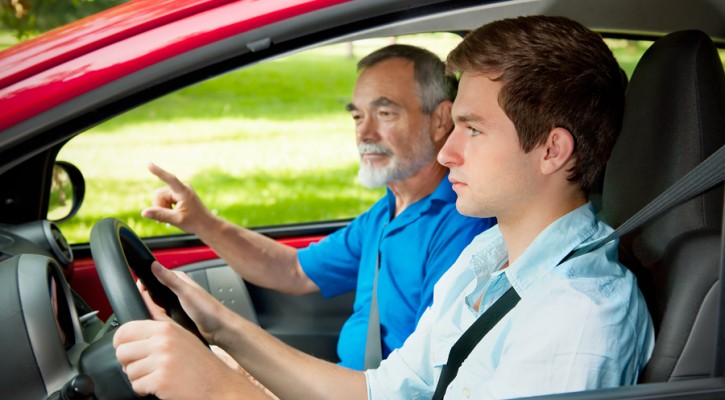
Driver Education: Traffic Safety for New High School Graduates
June 5, 2009
Summer is here and school is out. Many young drivers will be spending more time on the road going to the beach or pool, working at summer jobs, and having fun with friends. This is an especially exciting time for teens who are 2009 high school graduates. Recent grads are filled with elation, a sense of freedom, and hopes and dreams for the future. But euphoria and increased independence can cause problems when they lead relatively inexperienced drivers to take chances behind the wheel. And summertime is a dangerous time for drivers in general; traffic deaths for all drivers increase during the warm-weather months, peaking in July.
Three deadly holidays take place during the summer – Memorial Day, the Fourth of July, and Labor Day. According to the National Center for Statistics and Analysis, in a 2004 analysis of six holiday periods, the average number of traffic deaths during holiday periods was 156 per day, compared to 117 per day on non-holidays. According to the National Highway Traffic Safety Administration, 20 of the 25 deadliest days on US roads over a five-year time frame fell during the period from Memorial Day weekend to Labor Day.
Teen motor vehicle fatalities are also highest in the summer, partly because it’s an unsafe time for all drivers, but also due to risk factors specific to young drivers. Like other drivers, teens spend more time on the road during the summer (averaging 44% more hours driving each week, according to the NHTSA) and are more likely to drive at night. But they lack the experience of older drivers in dealing with heavy traffic and low-visibility conditions. Like other drivers, teens behind the wheel in the summer are often accompanied by multiple passengers. But teens are often much more distracted by their passengers than older drivers, and they are unlikely to assert themselves even when they are aware that they need to concentrate on driving.
Parents who want their teens to survive the summer must stay involved in their teens’ driving activities. Without close supervision, the vast majority of teens lack the emotional maturity to stay safe behind the wheel – or as passengers of other teen drivers.
-Though most parents will broaden driving privileges for summer, avoid giving teens too many privileges at once. Extend privileges one at a time and make sure teens prove they can handle the increased responsibility before adding more.
-Conduct supplementary driver training lessons. For example, many teens have limited experience with night driving during the school year; a few lessons will help them learn good nighttime driving habits from the beginning. A teen driving checklist helps parents provide valuable feedback on the driving lesson.
-A driver training course will help teens review fundamental driving concepts during a time when they are most at risk. A quick safe-driving refresher could help an inexperienced young driver make the right choice in an emergency. Parents whose teens receive even one traffic ticket must address the issue immediately; tickets mean teens are probably engaging in more risky driving behaviors than parents realize.
-Parents should check up on their teens’ seat belt use as often as possible. In 2006, the NHTSA reported that 58% of 16- to 20-year olds who were involved in fatal motor vehicle collisions were not wearing seat belts. The Insurance Institute for Highway Safety reports that teen seat belt use increases over time when strict parental limits are set.
-A heightened level of awareness about their teens’ access to alcohol, particularly on holidays, is critical for concerned parents. Teens may even have access to alcohol via their friends’ parents; ensure that teens understand that underage drinking is never acceptable, no matter what any other parent says or does, even for a special occasion. Create a codeword so your teen can ask to be picked up without risking the ridicule of friends.

Driver Training: Teens and Seat Belt Use
May 28, 2009
As many drivers know, teens have a higher fatality rate in motor vehicle crashes than any other age group. One reason for this is that teens have lower seat belt use rates than adults. In 2006, the National Highway Traffic Safety Administration (NHTSA) reported that 76% of drivers aged 16 to 24 used their safety belts; this figure was lower than for any other age group. Perhaps more telling, in 2006 the NHTSA also reported that 58% of 16- to 20-year olds who were involved in fatal motor vehicle collisions were not wearing seat belts.
In some states, the numbers are even worse: An observational study by the Utah Department of Health found that the teen seat belt use rate was only 67% compared to a state safety belt use rate of 88.6%. The University of Missouri reports that between 1995 and 2000, only 24% of fatally injured teen drivers were buckled up, compared to the national average of 36% for teen drivers who died in motor vehicle crashes during this time.
Why don’t teens wear safety belts? The Utah Department of Health study reported that teens offer the following reasons:
- Forgetting to buckle up
- Wanting to be cool
- Peer pressure
- Seat belts are uncomfortable
- Traveling only a short distance
- A feeling of invincibility
The same study also found that the teen seat belt use rate falls when other high-risk factors are present, such as when teens:
- Drive under the influence of alcohol
- Drive at night
- Have multiple teen passengers
- Are driving without a driver’s license
What can we do to increase the seat belt use rate among teenagers? Initiatives include:
- The University of Missouri study found that whether or not teens will use safety belts is established well before the teens begin driving. Parents who want their teens to buckle up must wear their own safety belts and use child restraints and seat belts on their children from birth. The University of Missouri study found that teens were heavily influenced by a lack of seat belt use by the adults in their lives, and the Insurance Institute for Highway Safety reports that teen seat belt use increases over time when strict parental limits are set. In an NHTSA study, about half of the unbelted students observed at 12 high schools were riding with adults who were wearing seat belts.
- Education and outreach are important methods of encouraging safety belt use. Many teens do not understand the physics of a car crash. The University of Missouri study found that teens are not well-informed about the consequences of crashes where occupants are unbelted. Teens also tend to extrapolate urban legends to a statistical majority, so they need to learn how to apply critical thinking skills to traffic safety concepts.
- Graduated Driver Licensing programs in many states have seat belt use requirements. For example, in North Carolina, graduated licensing law includes provisions for fines for up to $100 for safety belt violations by new drivers. Teens need to be educated on their state requirements and the penalties for violating them; parents need to enforce GDL laws as part of their house rules.
- Parents who are purchasing a vehicle for their teens should consider models with safety belt reminder systems.
- Schools have the opportunity to increase seat belt use by requiring student drivers and passengers to be buckled up when entering and leaving campus. Enforcement can be tied to vehicles with parking decals; penalties can be tied to restriction of and eventual loss of parking privileges.
- A primary enforcement safety belt law is effective in increasing safety belt use among teens, particularly among those who absolutely refuse to wear them otherwise. The NHTSA reports that teens are more likely to wear seat belts in states with primary enforcement laws versus in states with secondary laws. Teens often perceive indifference to safety belt use on the part of law enforcement in secondary enforcement states, because they don’t understand that enforcement is restricted by the law.
“Click It or Ticket” campaigns are also successful in increasing overall seat belt use rates.

Driver Education: Why New Drivers Should Take a Defensive Driving Class
May 27, 2009
Though teens receive driver training prior to being licensed and are subject to Graduated Driver Licensing laws to protect them from statistically high-risk driving situations, training shouldn’t end when teens get their licenses. Reasons for this include:
1. Newly licensed teenage drivers are often giddy with newly acquired freedom. They will assimilate more information once they have become accustomed to the increased level of independence they’ve earned.
2. Teens may pick up bad driving habits, such as carelessness and recklessness, from riding with other teens.
3. Teens who received defensive driving lessons prior to gaining driving experience often have difficulty applying those lessons until they are licensed.
4. New drivers often suffer from information overload; spreading driver training lessons out over time means they will retain more in the long run.
5. Though drivers are statistically less likely to be injured or killed in motor vehicle crashes as they leave their teens, the overall risk remains high throughout the teenage years when compared to other age groups.
Taking a defensive driving course six to twelve months after licensure is very helpful for new drivers. Teens can take the course online or in a classroom. Typical topics include:
- Crash statistics and the physics of vehicle crashes
- Crash prevention techniques
- Occupant protection devices (such as seat belts and airbags)
- Driving under the influence of alcohol
- How to share the road with large trucks, motorcyclists, and pedestrians
- Dealing with stress and drowsiness while driving
- The hazards of speeding
- An overview of traffic laws in your state
When teens take a defensive driving class, they have the opportunity to apply concepts that may have seemed abstract prior to licensure. For example, crash prevention techniques are easier to appreciate once the driver has experience in maneuvering a vehicle; unlicensed teens are unlikely to understand how much stress and sleepiness negatively impact their driving abilities. However, as newly licensed drivers, teens haven’t been driving long enough to have ingrained driving habits, so they still have an opportunity to eliminate unsafe practices and become safe drivers.

Driver Education: Teens and Defensive Driving
May 20, 2009
Teens are often urged to “drive defensively.” This is an excellent suggestion for any driver and is of particular importance to new drivers, who have limited experience in dealing with emergency situations and who are developing driving habits they may have for the rest of their lives. But what is defensive driving, exactly?
Driving defensively means driving in such a way that you reduce the risk of a crash, which will in turn prevent injury to yourself and others. It means going beyond following the rules of the road to put safety first. For example, if another driver is supposed to yield the right-of-way to you but fails to do so, as a defensive driver you will yield the right-of-way to that driver to avoid a collision.
Defensive driving isn’t just important in emergency situations, however. Using defensive driving techniques will help you:
- manage stressful driving conditions
- avoid traffic tickets
- keep your vehicle in good mechanical condition
- keep your driver’s license
There is no doubt that driving can be stressful, especially when traffic is heavy. One element of defensive driving is to maintain an adequate following distance from the vehicle in front of you. This decreases the risk of a rear-end collision if the vehicle ahead stops suddenly. Other ways to manage stress by driving defensively include:
- driving at a speed that is appropriate for conditions (which may be lower than, but is never higher than, the posted speed limit)
- checking intersections for cross traffic when you have a green traffic light (in case another driver runs the red light or a pedestrian is in the crosswalk)
- keeping a space cushion on all sides of your vehicle so you have room to maneuver if necessary
- watching the road ahead of your vehicle and checking your mirrors every three to five seconds so you notice hazards before they become a problem
Avoiding traffic tickets is especially important to drivers who are subject to a Graduated Driver’s Licensing program; these programs often restrict advancement to the next stage of licensure unless very few or no points accrue on the teen’s license. Traffic violations also mean hefty insurance increases for young drivers, who are already paying high rates because they are in a high-risk category. But following the rules of the road only when you’re worried about getting a ticket is not sufficient; if you’re not concentrating on driving defensively, you’re likely to make mistakes due to your reduced level of alertness. These mistakes could result in a ticket or even a crash, and even a minor fender-bender can result in points on your driving record.
Part of defensive driving is making sure that your vehicle is in good mechanical condition. Don’t wait for a breakdown to get your vehicle checked out; your owner’s manual offers a schedule of suggested maintenance tasks. Tires with low air or worn tread reduce your traction and make skids more likely. Your brakes need to be in top condition at all times. Even something as simple as not having windshield wiper fluid in the reservoir can impair your visibility and increase your chances of a crash. Don’t just put gas in the car and drive; take responsibility for ensuring that your vehicle is ready for the road.
As you’ve probably learned from your driver handbook, having a driver’s license is a privilege, not a right. This means that your driver’s license can be taken away, including for some non-driving offenses.
Driving defensively is part of an overall pattern of responsible behavior that will help you keep your license and the increased level of independence that comes with it.

How Teens Can Drive Safely on the Expressway
June 9, 2009
A complete driver-training program includes lessons on all types of streets and highways, both night and day, in a variety of weather and traffic conditions. But many teens get the majority, if not all, of their driver training on familiar roads close to home. Some young drivers do not make their first expressway trip until after they are licensed and driving on their own. This is a high-risk method for teens to gain driving experience, because:
Commentary driving is an excellent way to train teens to drive safely on the expressway. With commentary driving, teens maintain a running dialogue of their progress – what they notice as they observe the roadway and what actions they will take: “The car in front of me is slowing down, so I’m slowing down and checking my following distance. My exit is coming up in one mile, so I’m putting on my turn signal, checking my mirrors and blind spot, and moving into the exit lane. The exit ramp has a posted speed limit of 45 mph, so I’m slowing to that speed. It’s starting to rain, so I’m increasing my following distance.”
Commentary driving forces the driver to use critical thinking skills to make driving decisions. The fact that the driver’s observations are verbalized is comforting to the person (typically a parent) teaching the teen to drive, because it allows the instructor to follow the teen’s thought process and quickly make corrections without lecturing, which teens tend to tune out anyway.
Teens often feel awkward about commentary driving, so it is helpful to model it for them prior to beginning driving lessons. This also allows parents to perfect the process and to see the roadway with new eyes, thus relating better to the beginning driver.
From a practical standpoint, it is obviously important for teens to work up to practicing driving on the expressway. The first several lessons should occur during non-peak hours on dry roads during the daytime. Introduce one variable – nighttime hours, rainy weather, rush-hour traffic – at a time, and ensure the teen is completely comfortable with each before progressing to the next.
The following training tips will help teens be safer drivers on the freeway: